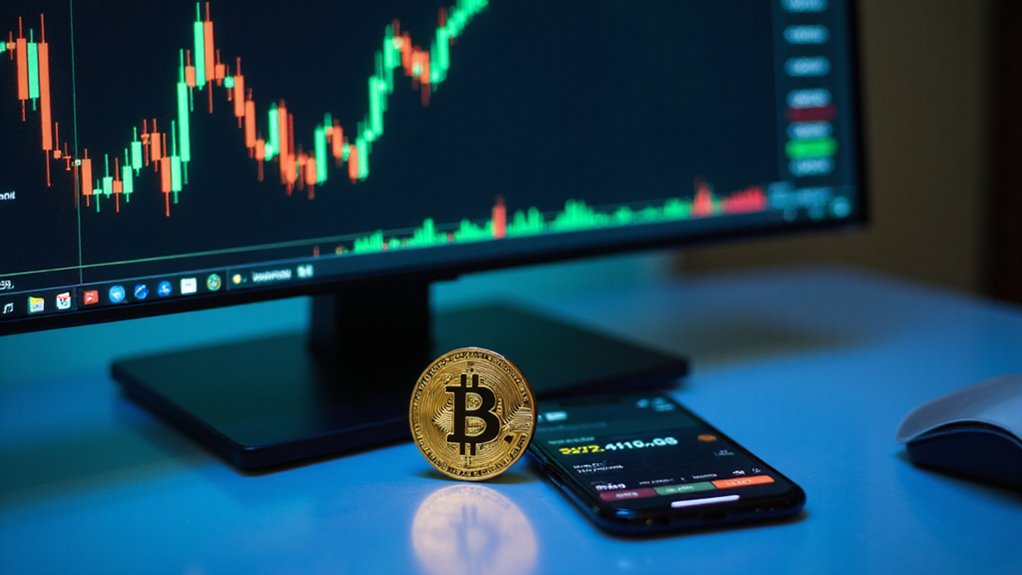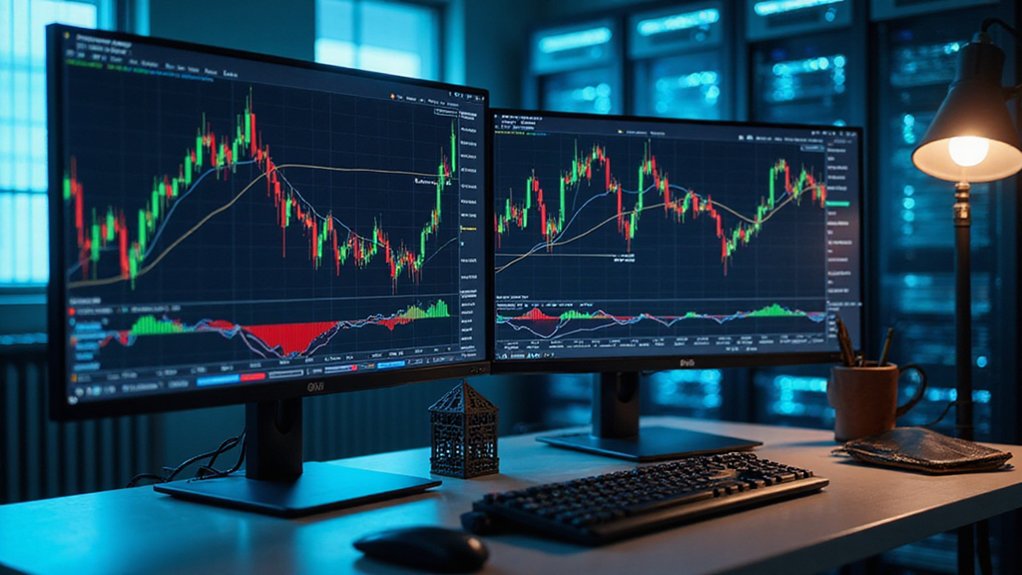Spot trading in cryptocurrency represents the straightforward exchange of digital assets at current market prices with immediate settlement. Unlike futures or derivatives, traders gain actual possession of the cryptocurrencies rather than mere exposure to price movements. The process operates through centralized exchanges (Coinbase, Gemini) or decentralized platforms, utilizing market orders for immediate execution or limit orders for preset price targets. This fundamental trading approach minimizes leverage risk while demanding vigilance in managing the notorious volatility that makes crypto markets simultaneously terrifying and irresistible.

While the cryptocurrency market continues to evolve at a dizzying pace, spot trading remains one of its most fundamental and accessible entry points for investors of all experience levels.
At its core, spot trading represents the straightforward exchange of assets at current market prices with immediate settlement—a welcome simplicity in a domain increasingly cluttered with derivatives and synthetic instruments.
Spot trading cuts through crypto complexity with immediate asset exchanges—clarity amid the noise of financial innovation.
Unlike its more complex cousins in the trading ecosystem, spot transactions transfer ownership directly and instantaneously, providing traders with actual possession of their digital assets rather than mere exposure to price movements.
The mechanics of spot trading operate through various platforms such as Coinbase and Gemini, where users establish accounts, deposit funds (fiat or crypto), and execute trades when matching orders appear in the order book.
This direct approach to market participation enables nimble responses to price fluctuations—a vital advantage in markets where volatility remains an enduring characteristic rather than an aberration.
The transparency inherent in spot trading allows investors to clearly discern the precise market value of assets at any given moment, unobscured by the financial engineering that often clouds other trading modalities.
The absence of leverage in spot trading serves as both limitation and safeguard.
While it constrains potential returns (much to the chagrin of those seeking overnight fortunes), it simultaneously eliminates the existential threat of margin calls that have unceremoniously terminated many a trader’s career.
This trade-off epitomizes the inherent risk-reward balance that defines financial markets¹.
Success in spot trading demands continuous market vigilance, rapid decision-making capabilities, and the emotional fortitude to navigate precipitous price swings without succumbing to panic or euphoria.
Regulatory frameworks surrounding spot trading vary considerably across jurisdictions, creating a complex compliance landscape for market participants.
Despite these challenges, the straightforward nature of spot trading—buying low and selling high, without contractual obligations for future transactions—remains an enduring strategy in the volatile world of cryptocurrency investing.
Traders can utilize both market and limit orders to execute their strategy effectively, allowing for either immediate execution at current prices or preset transactions when specific price targets are reached.
Spot trading allows investors to leverage their purchased assets for yield generation through participation in decentralized lending pools, creating additional income streams beyond simple price appreciation.
Unlike futures or options trading, spot transactions in cryptocurrency typically settle within minimal timeframes, making them ideal for traders who prioritize immediate asset delivery and ownership.
¹A fact often forgotten during bull markets and painfully remembered during corrections.
Frequently Asked Questions
What Are the Tax Implications of Crypto Spot Trading?
Crypto spot trading incurs capital gains tax—the IRS, in its infinite wisdom, treats digital assets as property rather than currency.
Transactions trigger either short-term gains (taxed as ordinary income at 10-37%) or long-term gains (more favorable 0-20% rates for assets held beyond a year).
Every swap between cryptocurrencies constitutes a taxable event, requiring meticulous record-keeping of cost basis and fair market value.
Form 8949 awaits the dutiful taxpayer, regardless of their blockchain enthusiasm.
How Does Spot Trading Differ From Futures Trading?
Spot trading involves immediate ownership transfer and settlement of crypto assets at current market prices, while futures trading entails contractual agreements for future delivery at predetermined prices.
The former confers instant asset control without leverage, limiting risk to price volatility alone; the latter typically employs leverage, amplifying both potential returns and losses.
Spot trading serves those seeking actual cryptocurrency possession, whereas futures cater to sophisticated speculators and hedgers who prefer position-taking without immediate asset ownership—quite the fundamental distinction.
Can I Automate My Spot Trading Strategies?
Yes, spot trading can be fully automated through specialized trading bots.
These algorithmic assistants execute transactions based on predetermined parameters—technical indicators, price thresholds, or market volume changes—without human intervention.
Platforms like 3Commas, Bitsgap, and exchange-native solutions offer turnkey automation, while programming-savvy traders might deploy custom solutions through exchange APIs.
One must weigh the convenience against potential risks: technical failures, security vulnerabilities, and the ever-present possibility that algorithms (however clever) might spectacularly misread market conditions.
What Security Measures Should I Take When Spot Trading?
Security for spot trading demands a fortress-like approach: safeguard private keys offline (preferably in hardware wallets), employ robust 2FA (authenticator apps trump SMS), and implement whitelisting for both IP addresses and withdrawal destinations.
One cannot overstate the importance of unique passwords managed through dedicated software—the digital equivalent of Cerberus guarding the underworld.
Regular software updates and network security (via VPNs) complete this defensive perimeter against the relentless onslaught of crypto predators lurking in the market’s shadows.
How Do Spot Trading Fees Compare Between Different Exchanges?
Spot trading fees vary greatly across exchanges, with structures predicated on trading volume, maker/taker status, and proprietary incentive programs.
Binance and KuCoin deploy tiered VIP systems rewarding high-volume traders, while Crypto.com leverages its native token to offer discounted rates (a clever retention strategy, one might note).
The astute trader recognizes these fee differentials—often ranging from 0.1% to 0.5%—represent meaningful cost variables that, compounded over time, substantially impact overall trading profitability.









